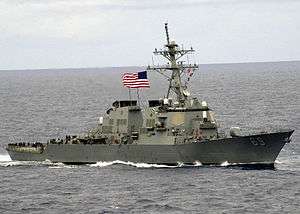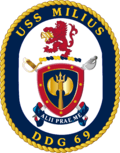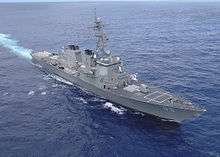USS Milius
USS Milius (DDG-69) is an Arleigh Burke-class Aegis guided missile destroyer of the United States Navy. It is the first United States Navy Ship named after an POW/MIA from the Vietnam War. Her namesake is Captain Paul L. Milius (1928-1968), a Naval Aviator presumed killed following the crash of his aircraft over Laos in February 1968. Captain Milius's daughter, Annette, became the sponsor and later christened the ship named in honor of her father. [2]
 USS Milius Milius at sea in 2003 | |
| History | |
|---|---|
| Name: | USS Milius |
| Namesake: | Commander Paul L. Milius |
| Ordered: | 8 April 1992 |
| Builder: | Ingalls Shipbuilding |
| Laid down: | 8 August 1994 |
| Launched: | 1 August 1995 |
| Sponsored by: | Annette Milius |
| Christened: | 28 October 1995 |
| Commissioned: | 23 November 1996 |
| Homeport: | Naval Base Yokosuka, Japan[1] |
| Motto: | Alii Prae Me - "Others Before Me" |
| Status: | in active service |
| Badge: |
 |
| General characteristics | |
| Class and type: | Arleigh Burke-class destroyer |
| Displacement: |
|
| Length: | 505 ft (154 m) |
| Beam: | 66 ft (20 m) |
| Draft: | 31 ft (9.4 m) |
| Propulsion: | 4 General Electric LM2500-30 gas turbines, two shafts, 100,000 total shaft horsepower (75 MW) |
| Speed: | >30 knots (56 km/h; 35 mph) |
| Range: |
|
| Complement: | |
| Sensors and processing systems: |
|
| Electronic warfare & decoys: |
|
| Armament: |
|
| Aircraft carried: | 2 Sikorsky MH-60R helicopters can be embarked |
Namesake
The ship's namesake is Commander Paul L. Milius (1928-1968) of U.S. Navy squadron VO-67. His OP-2E aircraft, callsign Sophomore 50, was hit by anti-aircraft fire over Laos on 27 February 1968. Petty Officer John F. Hartzheim, an Avionics Technician assigned to the aircraft, was struck by fragments of the projectile and began bleeding profusely. The radar well burst into flames, filling the flight deck area of the aircraft with dense, acrid smoke. Commander Milius ordered his crew to bail out. Ensign Thomas G. Wells suffered serious burns to his hands as searched in vain for a fire extinguisher to quell the blaze in the radar well of the aircraft. During the search, he realized that the rest of the crew had left the aircraft and only he, AT2 Hartzheim, and Commander Milius remained. Hartzheim was carried to the after station by the Tactical Coordinator. Upon arriving in the after station, Hartzheim stated that he could not go any farther, and collapsed. Other crew members later stated they believed Hartzheim died at this time, as his eyes were wide open and rolled to an upwards position and there was no movement. Milius was at this time still seated at the controls of the aircraft. Ensign Wells followed Milius out of the aircraft into the jungle below. Seven of the nine men aboard were rescued by the 37th Air Rescue Recovery Squadron Jolly Green Giants. Commander Milius was initially in radio contact with rescue helos on the day of the crash. The next day, only his radio beacon was heard and the rescue mission had to be aborted due to heavy enemy gunfire. A search effort on 29 February 1968 called Operation Texas Crest, continued for Paul Milius, but failed to locate any trace of him. The remains of the eighth crewmember, ATN2 John Hartzeim, who was wounded in the attack, were identified on 19 February 1999. Although he exited his aircraft, Commander Milius was never recovered. In August 1968, a NVA soldier whose unit moved south along Route 137 during the same timeframe that the Neptune was shot down defected to US control. He reported that during infiltration, his unit captured a US Colonel with a survival radio. The approximate date of capture was March 1968, but the precise location was not pinpointed. Military intelligence personnel considered the defector's information truthful, correlated this report to Cmdr. Milius and placed a copy of it in his casualty file. [3] He was promoted to the Rank of Captain on 1 July 1972. On 26 April 1978, he was officially pronounced 'presumed killed in action' and posthumously awarded the Navy Cross. CAPT. Paul L. Milius has a Memorial Stone Placed at Harlington Cemetery Waverly Bremer County Iowa, USA. He was survived by his wife Darlene, daughter Annette and son David. [4] His Wall/Plot Coordinates on the Vietnam Veterans Memorial are 41E 051.
Navy Cross Citation
Awarded posthumously for actions during the Vietnam War
The President of the United States of America takes pride in presenting the Navy Cross (Posthumously) to Captain [then Commander] Paul Lloyd Milius, United States Navy, for extraordinary heroism on 27 February 1968 as an Aircraft Commander in Observation Squadron SIXTY SEVEN (VO-67). During a combat mission in Southeast Asia, Captain Milius' aircraft received multiple hits from 37-mm. anti-aircraft-artillery fire during a run over the assigned target. Immediately, the aircraft burst into flames, several members of the crew received injuries, and dense smoke and fumes filled the fuselage. Remaining at the controls to insure stable flight, Captain Milius ordered his crew members to bail out. As a result of his action, seven of his nine crewmen were rescued within three hours of bail-out. Rescue flights, however, were unable to locate Captain Milius. His heroic efforts and inspiring devotion to duty were in keeping with the highest traditions of the United States Naval Service.
Ships history

In January 2005, Milius participated in Operation Unified Assistance. On 6 December 2006, the ship successfully launched a Block IV Tomahawk cruise missile for the first time in a test of the Block IV configuration. The launch took place in the Naval Air Warfare Center Weapons Division Sea Test Range off of California. The missile flew 869 miles before impacting its target on the land range at China Lake, California.
On 12 September 2007, the Embassy of the United States, Manila stated that the arrival of the destroyers USS Chung-Hoon and USS Milius was a goodwill visit to strengthen Philippines–United States relations.[5]

Deployments
- 26 May 1998-September 1998 Maiden deployment [6]
- 22 June 2000-December 2000 West Pac-Indian Ocean-Persian Gulf [7]
- 2 November 2002 – 2 June 2003 West Pac-Indian Ocean-Persian Gulf [8]
- 6 December 2004 – 6 June 2005 West Pac-Indian Ocean-Persian Gulf [9]
- 10 April 2007 – 8 October 2007 Scheduled Deployment with BHR ESG [10]
- December 2008-July 2009 West Pac-Indian Ocean-Persian Gulf [11]
- 18 May 2010 – 16 December 2010 West Pac-Indian Ocean-Persian Gulf [12]
- 11 January 2012 – 11 September 2012 West Pac-Indian Ocean-Persian Gulf [13]
- 20 October 2014 - 25 June 2015 West PAC- Indian Ocean-Persian Gulf [14]
- May 2018-TBD Forward deployed to 7th Fleet, USS Milius changes homeport from San Diego, CA to Yokosuka, Japan. [15]
Coat of arms
The ship’s crest is designed in remembrance of the military service of the ship’s namesake, Captain Paul Lloyd Milius, and the courage and dedication that promoted his selfless act of heroism.
Dark blue and gold are colors traditionally used by the Navy and denote the sea and excellence. The shield itself reflects the power of the Aegis shield. The double-edged battle-ax symbolizes the power of the modern guided missile destroyer. The battle-ax harnesses is a warning that peace should be maintained; provoked and unleashed, the battle-ax is a punishing offensive weapon capable of delivering crushing blows. The trident reflects the prowess of MILIUS, capable of projecting sea power on the land, in the air, and on and beneath the sea. The crossed swords are the modern Navy sword of today and the cutlass of the John Paul Jones era symbolizing the enduring tradition and heritage of the United States Navy. The border, for unity, is red highlighting readiness for action and sacrifice, if necessary. The seven bolts on the border represent the seven lives saved by Captain Milius’ heroic action.
The lion suggests Captain Milius’ extraordinary heroism as the aircraft commander in Observation Squadron Sixty-Seven for which he received the Navy Cross, represented by the cross plate, and underscored his selfless courage and inspiring devotion to duty.
ALii Prae Me, or “Others Before Myself,” was chosen to reflect the personal ethic held throughout Captain Milius’ military career and his selfless act under fire.
Awards
USS Milius has been awarded the Navy Battle "E" three times
- 01-Jan-2002 31-Dec-2002
- 01-Jan-2012 31-Dec-2012 [17]
- 01-Jan-2015 31-Dec-2015
- PACFLT 2003 Retention Excellence Award Winner
- PACFLT 2002 Marjorie Sterrett Battleship Fund Award
Ship awards
| Ribbon | Description | Notes |
| Navy "E" Ribbon | with three Battle E devices | |
| National Defense Service Medal | ||
| Global War on Terrorism Expeditionary Medal | ||
| Global War on Terrorism Service Medal | ||
| Navy Sea Service Deployment Ribbon | with one silver service star |
References
This article includes information collected from the Naval Vessel Register, which, as a U.S. government publication, is in the public domain.
- "USS Milius Bids Farewell to San Diego and Begins Transit to Japan". public.navy.mil. Retrieved 23 April 2018.
- https://www.findagrave.com/memorial/59428034/annette-celeste-milius
- http://www.taskforceomegainc.org/m060.html
- https://navy.togetherweserved.com/usn/servlet/tws.webapp.WebApp?cmd=ShadowBoxProfile&type=EventExt&ID=233404
- Inquirer.net, US warships arrive in RP Archived 2007-09-14 at the Wayback Machine
- https://www.public.navy.mil/surfor/ddg69/Pages/namesake.aspx
- https://www.public.navy.mil/surfor/ddg69/Pages/namesake.aspx
- https://www.public.navy.mil/surfor/ddg69/Pages/namesake.aspx
- https://www.public.navy.mil/surfor/ddg69/Pages/namesake.aspx
- https://www.public.navy.mil/surfor/ddg69/Pages/namesake.aspx
- https://www.public.navy.mil/surfor/ddg69/Pages/namesake.aspx
- https://www.public.navy.mil/surfor/ddg69/Pages/namesake.aspx
- https://www.public.navy.mil/surfor/ddg69/Pages/namesake.aspx
- https://www.pacom.mil/Media/News/News-Article-View/Article/602044/uss-milius-returns-from-deployment/
- https://news.usni.org/2018/05/22/33759
External links
| Wikimedia Commons has media related to USS Milius (DDG-69). |